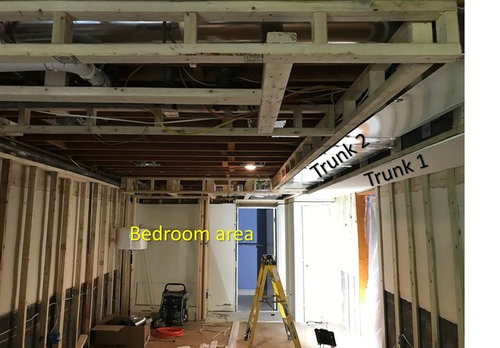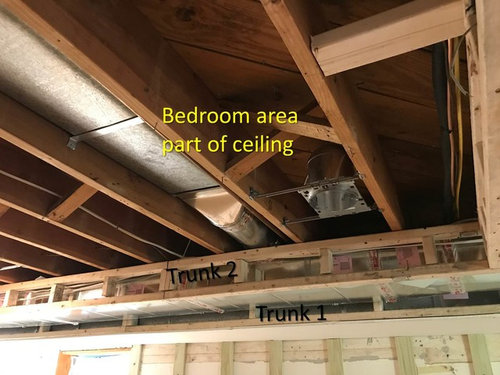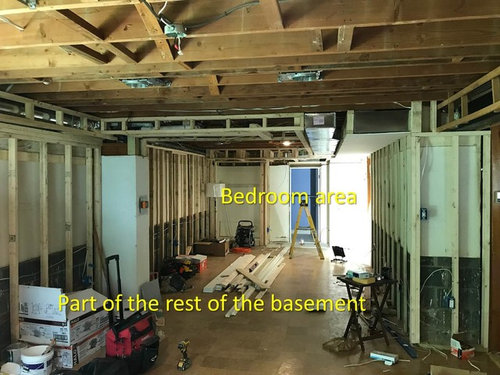Yikes!!! How do I best soundproof my basement ceiling? Advice help! :)
I am having my basement finished right now. The old ceiling has been removed so that all the HVAC and pipes have been nestled in so I can have 8' foot ceilings throughout the basement for the most part. Yay!
I really need to decide quickly about how best to reduce the amount of noise that comes from people walking on the floors above, so I guess that's impact noise. There are no carpets above, nor will there be, just hardwood floors. The basement "bedroom" is directly below the kitchen where there is a lot of action. It's now or never on need to make the right decision about the "soundproofing" the basement ceiling from the noises from the main floor.
I have suggested to my contractor (who is wonderful) to use Rockwool Safe n Sound (15.25 inch W by 47 inch Long) between the rafters which are about 14 inches apart. He was planning on using Acoustical Surfaces Inc.'s SOUNDBREAK XP, an acoustically enhanced gypsum board https://www.acousticalsurfaces.com/soundbreak/soundbreak.htm. So right now the plan is to use the Rockwool Safe n Sound with the Soundbreak XP.
I read and reread suggestions throughout the web and even on Houzz, but I'm still not sure what to do. The soon to be finished part of the basement is about 850 sq feet. About 1/3 of that space is "bedroom" area. That area I'm most concerned about noise.
- Should I do two layers of Rockwool throughout the entire basement or just where the bedroom is?
- Should I consider another product like Owens Corning Termafiber Fire and Sound Guard Mineral Wool Insulation Batt 15 in. by 47 in. as it's significantly cheaper?
- Should I insist that the contractor use resilient channel in the bedroom area?
- Are these bad ideas?
- Do you have any better ideas?

I'm feeling confused as to how to proceed. The contractor was going to do the insulation a week or two from now, but he'll be starting on Tuesday instead, so I really need to make a decision soon.
Thank you for reading this, and I'd really appreciate some good advice as how to proceed so my contractor can move forward on the project.



Comentarios (6)
gadzooks1
Autor originalhace 4 añosAlso, when installing these mineral insulation batts, should that be pushed up to right below the upstairs flooring OR should they hang low next the basement ceiling drywall? Thanks.
SJ McCarthy
hace 4 añosI would also add that you want the heating ducts and plumbing pipes wrapped with insulation as well. Right now is the PERFECT time to do it because everything is exposed. Metal (like duct work) LOVES to transmit noise (telephone WIRES are METAL...ahem...just saying). Wrap those puppies and you will have removed a HUGE source of sound from multiple areas of the house (there is NOTHING like hearing the details of someone's day via the duct work from two stories above...at 1am).
I've always liked the 'double stuffing' of the ceiling. If you double stuff the joists (two layers of mineral wool instead of one) then you can probably go with the lower priced product. So long as their densities are the same and the material make up are the same then you should get awfully close to the same ratings.
Use the resilient channels throughout...you can't think of the bedroom as being one area and the rest another...if one part 'leaks' noise then the other part will too. Think of the entire space as a bathtub. If you have a hole in one end of the bathtub, it will leak because the water will find it's own level. Noise kinda does the same thing.
The other option, if you don't want to use the resilient channels (because you want the ceiling height maintained) then you can look at Green Glue liquid acoustic barrier. There *MIGHT be an application where they apply the liquid/foam to the joists and then mount/screw the drywall to the joists. Green Glue also produces drywall/foam additive that can be used INSIDE the holes for the screws (you drill the pilot hole, you fill it with the foam/liquid and then drive the screw into place). This acts like a mini-resilient channel.
And then use the acoustic drywall. And remember your SOLID CORE door for the bedroom. That way you reduce every ounce of noise moving from the basement area into the bedroom area.
You should be fine using ALL of the options open to you. You can never have too much noise abatement. You really can't. Silence is silence. Once you achieve it, it is difficult to figure out which bit was 'overkill'.gadzooks1 agradeció a SJ McCarthyMy House
hace 4 añosÚltima modificación: hace 4 añosHave you never lived in an apartment? Granted they might be not constructed with all the latest updates on soundproofimg, but they are designed to have people living on top of one another, where the top floor is always the quietest. Considerate upstairs neighbors minimize the noise by walking in a Reverse Walk- toe first then soft heel, as opposed to the loud stomping sound created by the usual gait- heel roll to toe. I hope there aren't midnight snackers in your home, or else the poor unfortunate soul in the basement will have a terrible night's sleep. (Hardwood, no sound-muffling carpet- yikes)
Also... Do you have dogs? Dogs walk with a jaunty gait at all hours - thud thud thud thud thud -plop on the floor
This Old House Soundprooffing. https://www.thisoldhouse.com/discussions/topic/sound-proofing-solutionsgadzooks1 agradeció a My Housegadzooks1
Autor originalhace 4 añosÚltima modificación: hace 4 años@SJ McCarthy , how do you recommend wrapping the duct work? Also, so many thanks for your suggestions! :)

Volver a cargar la página para no volver a ver este anuncio en concreto
A V